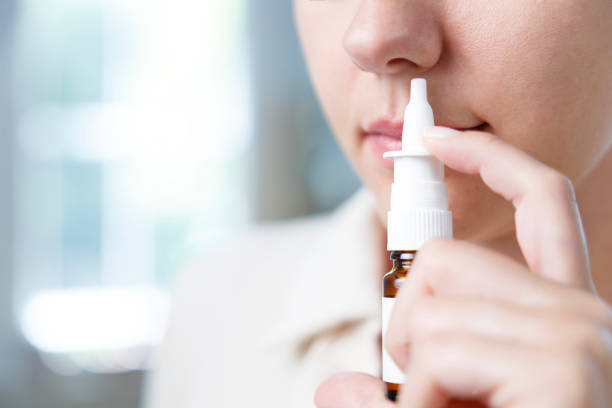USP Nasal Spray Bioburden Testing
The USP Nasal Spray Bioburden Test is a critical quality assurance procedure designed to ensure that nasal spray products are free from unacceptable levels of microorganisms, which can lead to contamination and potential safety issues. This test is particularly important for pharmaceutical products intended for direct contact with the mucous membranes inside the nose.
The primary objective of this testing is to provide data on the microbial content present in the product before it reaches the consumer. The test aims to identify any potential risks associated with microbial contamination, ensuring that the nasal spray meets strict USP standards and regulatory requirements for safety and efficacy.
Microbial contamination can arise from various sources during manufacturing processes or packaging materials, which can lead to serious health issues if not adequately controlled. By conducting this bioburden test, manufacturers can ensure their products meet stringent quality control measures, thereby enhancing consumer confidence in the product's safety.
The test is performed by inoculating a sample of the nasal spray onto appropriate culture media and incubating it under conditions that promote microbial growth. The number of colonies formed on the agar plates is then counted to determine the total viable count (TVC) or bioburden level of microorganisms present in the product.
The USP Nasal Spray Bioburden Test is typically conducted at two different dilutions, 1:10 and 1:100, depending on the expected microbial load. This allows for a more accurate representation of the bioburden levels across various concentrations. The test is performed in accordance with United States Pharmacopeia (USP) Chapter 71 and other relevant pharmaceutical standards.
The results of this test are essential for determining whether a nasal spray product can be considered safe for use. Compliance with USP guidelines is mandatory to ensure that the product meets the highest standards of quality, purity, and efficacy.
Scope and Methodology
| Step | Description |
|---|---|
| Sample Preparation | The nasal spray sample is collected in a sterile container and transported to the testing facility under controlled conditions to prevent contamination. |
| Dilution | The sample is diluted using appropriate physiological saline solutions at two different dilutions: 1:10 and 1:100. This helps ensure that the microbial count falls within a range suitable for accurate quantification. |
| Inoculation | The diluted samples are inoculated onto appropriate culture media, such as tryptone soy agar (TSA) or nutrient agar, and incubated at 35°C ± 2°C for 48 hours ± 1 hour under aerobic conditions. |
| Counting | The number of colonies on the agar plates is counted after incubation. This provides a quantitative measure of microbial contamination in the nasal spray sample. |
| Data Analysis | The results are analyzed to determine the bioburden levels and compared against acceptable limits specified by USP guidelines. |
Quality and Reliability Assurance
Ensuring consistent quality in pharmaceutical products is paramount, especially for nasal sprays that are used directly on the mucous membranes. The bioburden test plays a crucial role in maintaining this consistency by providing reliable data on microbial contamination levels.
The reliability of the USP Nasal Spray Bioburden Test is enhanced through stringent quality control measures at every stage of the testing process. From sample collection to final analysis, each step follows established protocols and guidelines provided by the United States Pharmacopeia (USP).
Regular calibration of equipment used in the test ensures accurate results. This includes maintaining precise temperature and humidity conditions during incubation periods and using calibrated pipettes for dilution steps. The use of standardized culture media further contributes to the accuracy and consistency of the test.
The laboratory performing these tests adheres to strict quality assurance protocols, including regular internal audits and external inspections by regulatory bodies. These measures help ensure that the bioburden testing is conducted in a controlled environment, reducing the risk of contamination or errors.
By consistently meeting USP standards, pharmaceutical companies can demonstrate their commitment to producing high-quality products that meet rigorous safety and efficacy criteria. This not only enhances consumer trust but also helps maintain regulatory compliance.
Environmental and Sustainability Contributions
- Reduction in Contamination Risks: By identifying and eliminating microbial contamination early in the production process, this test minimizes the risk of introducing harmful microorganisms into the environment. This helps protect both healthcare workers and patients from potential infections.
- Eco-Friendly Packaging: The use of eco-friendly packaging materials in nasal spray products contributes to reducing waste and promoting sustainability. By ensuring product safety through bioburden testing, manufacturers can choose sustainable packaging options without compromising quality.
- Resource Efficiency: Efficient testing methods ensure that resources are used optimally, minimizing waste and energy consumption. This includes optimizing the use of reagents and consumables during sample preparation and analysis.
- Educational Impact: The results from bioburden testing contribute to educational initiatives aimed at improving understanding of microbial contamination risks in pharmaceutical products. This knowledge can be used to develop better practices for preventing such issues.





